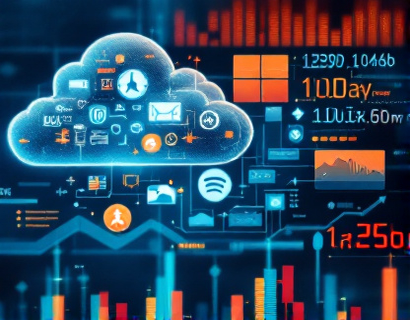Data-Driven Social Marketing: Transforming Business Engagement with Advanced Online Strategies
In the rapidly evolving landscape of digital marketing, businesses are increasingly turning to data-driven social marketing strategies to enhance their online presence and engagement. The integration of advanced analytics and sophisticated tools has revolutionized the way companies interact with their audience, optimize content distribution, and measure performance. This comprehensive guide delves into the transformative power of data-driven social marketing, offering advanced strategies to maximize digital engagement and ensure strategic success.
Understanding Data-Driven Social Marketing
Data-driven social marketing is an approach that leverages comprehensive data analytics to inform and optimize social media strategies. Unlike traditional methods that rely on intuition and guesswork, data-driven marketing uses empirical evidence to make informed decisions. This approach involves collecting, analyzing, and interpreting large datasets to gain insights into audience behavior, content performance, and campaign effectiveness.
The core of data-driven social marketing lies in its ability to provide actionable insights. By harnessing the power of big data, businesses can identify patterns, trends, and correlations that would otherwise remain hidden. These insights enable brands to tailor their content, target the right audience segments, and adjust their strategies in real-time for optimal results.
Key Components of Data-Driven Social Marketing
To effectively implement a data-driven social marketing strategy, businesses must focus on several key components. These include data collection, analysis, content optimization, audience segmentation, and performance measurement.
Data Collection: The first step is to gather relevant data from various sources. This can include social media analytics tools, website analytics, customer feedback, and market research. The data collected should cover a wide range of metrics such as engagement rates, click-through rates, conversion rates, and demographic information.
Analysis: Once the data is collected, it needs to be analyzed to extract meaningful insights. Advanced analytics tools can help process large datasets and identify key trends. Techniques such as predictive analytics, sentiment analysis, and A/B testing are crucial in understanding audience preferences and predicting future behavior.
Content Optimization: Insights from data analysis should directly influence content creation and distribution. By understanding what types of content resonate with the audience, businesses can create more engaging and relevant posts. This may involve adjusting the tone, format, and timing of content to align with audience preferences.
Audience Segmentation: Data-driven social marketing also emphasizes the importance of audience segmentation. By dividing the audience into distinct groups based on demographics, interests, and behaviors, businesses can tailor their messages to specific segments. This personalized approach increases the likelihood of engagement and conversion.
Performance Measurement: Continuous monitoring and evaluation are essential to the success of any marketing strategy. Data-driven social marketing involves setting clear KPIs and using analytics tools to track performance. This allows businesses to assess the effectiveness of their campaigns, identify areas for improvement, and make data-informed adjustments.
Advanced Strategies for Enhanced Audience Interaction
To truly maximize audience interaction, businesses must adopt advanced strategies that leverage data-driven insights. Here are some sophisticated techniques to consider:
Personalized Content Delivery: Utilize audience data to create highly personalized content. By analyzing user behavior and preferences, businesses can deliver tailored messages that resonate on a personal level. Personalization can significantly boost engagement rates and foster stronger connections with the audience.
Dynamic Content Adaptation: Implement dynamic content strategies that adjust in real-time based on user interactions. For example, if a user engages with a particular type of content, the algorithm can prioritize similar content in their feed. This adaptive approach keeps the audience engaged and interested.
Interactive Content: Create interactive content such as polls, quizzes, and live streams to encourage active participation. Interactive content not only increases engagement but also provides valuable data on audience preferences and behaviors.
Influencer Collaborations: Partner with influencers who align with your brand values and target audience. Influencer marketing can expand your reach and credibility, especially when combined with data-driven insights to select the most effective collaborators.
Community Building: Foster a sense of community around your brand by creating dedicated spaces for discussion and interaction. Data-driven insights can help identify the most active and influential community members, allowing for targeted engagement and loyalty programs.
Optimizing Content Distribution for Maximum Impact
Effective content distribution is crucial for maximizing visibility and engagement. Here are some data-driven strategies to optimize how and when your content is shared:
Optimal Posting Times: Analyze data to determine the best times to post based on audience activity. Different segments may be more active at different times, and adjusting your posting schedule accordingly can significantly improve engagement.
Cross-Platform Integration: Utilize data to identify which platforms your audience is most active on and tailor your content distribution strategy accordingly. A multi-platform approach can help reach a broader audience and increase overall engagement.
Content Recycling: Reuse and repurpose successful content to maximize its reach. Data analytics can help identify which pieces of content perform best and how they can be adapted for different platforms and audiences.
A/B Testing: Conduct A/B tests to compare different versions of content, headlines, and calls-to-action. This empirical approach helps identify the most effective elements and refine your distribution strategy over time.
Analyzing Performance Metrics for Strategic Improvement
To ensure continuous improvement, it is essential to regularly analyze performance metrics and use the insights gained to refine your social marketing strategy. Key performance indicators (KPIs) to focus on include:
Engagement Metrics: Track likes, shares, comments, and overall engagement rates to gauge audience interaction. High engagement indicates content relevance and resonance.
Reach and Impressions: Monitor the number of unique users who see your content and the total number of times your content is displayed. These metrics help assess the broadness of your reach.
Conversion Rates: Measure the number of users who take a desired action, such as making a purchase, signing up for a newsletter, or downloading a resource. Conversion rates are a critical indicator of campaign success.
Sentiment Analysis: Use sentiment analysis tools to understand the emotional tone of audience responses. Positive sentiment can signal brand loyalty and satisfaction, while negative sentiment may indicate areas for improvement.
Return on Investment (ROI): Calculate the financial return of your social marketing efforts by comparing the cost of campaigns to the revenue generated. ROI provides a clear measure of the financial impact of your strategies.
By regularly reviewing these metrics and adjusting your strategies based on the data, businesses can continuously optimize their social marketing efforts for better results.
Conclusion
Data-driven social marketing represents a paradigm shift in how businesses approach online engagement and content distribution. By leveraging advanced analytics and sophisticated tools, companies can gain deep insights into audience behavior, optimize their content, and measure the effectiveness of their campaigns with precision. Embracing these advanced strategies not only enhances brand visibility and engagement but also drives strategic growth and success in the digital landscape.











































